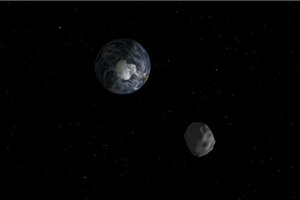NASA's 'intruder alert' spots cosmic flyby
Buzzed by an asteroid: With new advances in detection and tracking so-called Near Earth Objects, scientists hope to one day protect the Earth from asteroid threats.

The passage of asteroid 2012 DA14 through the Earth-moon system, is depicted in this handout image from NASA. On February 15, 2013, an asteroid, 150 feet (45 meters) in diameter passed by Earth.
NASA/JPL-Caltech/Handout/Reuters/File
[Story updated at 9:15 a.m. Monday.] Earth experienced a near miss on Sunday night as an asteroid passed near our planet. While the object posed no threat, it did get close, dodging us by only 310,000 miles. By comparison, the moon orbits about 240,000 miles from Earth.
Astronomers spotted this the Near Earth Object (NEO) thanks to an experimental "intruder alert" NASA program to detect and track potentially harmful space rocks passing close to our planet. The asteroid is one of many recent discoveries of NEOs as NASA and other international programs continue to refine techniques for discovering these potential threats from space.
In recent years, scientists have become increasingly concerned with the question of protecting Earth from potential collisions. For most of its history, humanity has relied on statistical unlikelihood to avoid catastrophic NEO impacts. But between advances in NEO detection and a proposed mission to test asteroid redirection, scientists hope to one day create a create a future in which concerns about asteroid collisions are a thing of the past.
This year, scientists have discovered more than 1,500 NEOs, according to the International Astronomical Union. Recently, the number of all-time discoveries passed the 15,000 mark, serving to highlight the importance of being able to spot and predict the paths of potentially destructive rocks in the night sky.
But while that number may seem concerning, it is actually a testament to new detection techniques like NASA's Scout system, a computer program that quickly identifies potential threats from a network of NASA-funded telescopes around the world. If it detects an NEO on a worrying course, it automatically instructs the telescopes to track the object to make sure its course is not getting to close for comfort.
"Objects can come close to the Earth shortly after discovery, sometimes one day, two days, even hours in some cases," NASA Jet Propulsion Lab's Davide Farnocchia told NPR. "The main goal of Scout is to speed up the confirmation process."
The asteroid that passed near the Earth Sunday evening was discovered on the night of October 25-26 by Panoramic Survey Telescope & Rapid Response System (Pan-STARRS) on Maui, Hawaii, a major global NEO detector. Using Scout, researchers were able to determine that the asteroid would pass close to Earth, but wouldn't pose a collision threat.
News of the near miss comes a month after the launch of OSIRIS-REx, a probe set to acquire a sample of the asteroid Bennu and send it back to Earth. Bennu, in addition to being a valuable source of scientific knowledge, also has a very small chance of its orbit decaying to a point where it could eventually pose a threat to people on Earth.
The rapid response to threatening asteroids like Bennu has become a priority for space agencies outside the United States as well.
"The rate of discovery has been high in the past few years, and teams worldwide have been discovering on average 30 new ones per week," Ettore Perozzi, manager of the NEO Coordination Center for the European Space Agency near Rome, Italy, said in a statement. "A few decades back, 30 were found in a typical year, so international efforts are starting to pay off. We believe that 90 percent of objects larger than 1000 m have been discovered, but – even with the recent milestone – we’ve only found just 10 percent of the 100 meter NEOs and less than 1 percent of the 40 meter ones."
The ESA is currently developing "fly eye" telescopes with extremely wide lenses to survey the sky for NEOs in order to assist NASA's detection network starting in 2018. They are also working with NASA to develop a way to nudge asteroids in order to shift their off of any potential collision course. The Asteroid Impact and Deflection Assessment (AIDA) mission will ultimately crash a NASA spacecraft into an asteroid in order to shift its course by a fraction of a percent while an ESA probe monitors the collision from a safe distance, gathering data about the viability of such a strategy as a planetary defense.
"If you know well in advance [about a threat from an NEO], and by well in advance I mean 10 years, 20 years, 30 years in advance which is something we can do, then you can divert such an asteroid by just giving it a tiny nudge when it's many billions of miles from hitting the Earth," Ed Lu, astronomer and CEO of B612, a company devoted to dealing with asteroid threats, told NPR.
"I believe in the next 10 to 15 years we'll actually be at the point where we as humans can say, 'Hey, we're safe from this danger of large asteroids hitting the Earth,'" he added.

